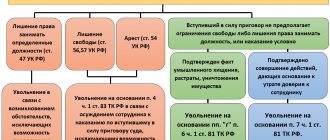Features of dismissal
The peculiarity of this form of termination of employment relations is that the employee terminates the professional contract with one employer and immediately enters into it with another. In this case, one condition must be observed: each party to such a process has no objections and agrees to the procedure.
Legislation
The main document providing for the most common and possible forms of termination of employment relationships is the Labor Code. For them, the issue of dismissal due to transfer is regulated in several articles, including as a general reason for breaking a professional contract: articles , , 72.1, 84.1, 169.
Also, the possibility of dismissal by transfer is enshrined in clause 5 of part 1 of article 33 of Federal Law No. 79-FZ of July 27, 2004 “On the State Civil Service of the Russian Federation.” This rule of law applies to state civil servants.
Download for viewing and printing:
Article 64. Guarantees when concluding an employment contract of the Labor Code of the Russian Federation
Article 77. General grounds for termination of an employment contract of the Labor Code of the Russian Federation
Article 72.1. Transfer to another job. Relocation of the Labor Code of the Russian Federation
Article 84.1. General procedure for registering termination of an employment contract under the Labor Code of the Russian Federation
Article 169. Reimbursement of expenses when moving to work in another area of the Labor Code of the Russian Federation
What does the Labor Code of the Russian Federation say about dismissal by transfer?
This type of termination of labor relations is referred to in clause 5 of part 1 of Art. 77 Labor Code of the Russian Federation. Permitted with the consent of the employee himself or his request. Moreover, they must be clearly expressed in writing.
Advantages and disadvantages
If an employee has found a new job and decided to leave the old one, then this option of dismissal will be good for him. This is a guarantee that the new employer will sign a contract within a month from the date of layoff. Another important advantage is that you will not need to undergo a probationary period at your new job .
The new employer, according to Article 64 of the Labor Code of the Russian Federation, guarantees employment. The employer who sent the invitation does not have the right to refuse the citizen to sign the contract and not hire him. Documents that guarantee employment are the invitation and consent of the employee.
If an employer refuses to employ an invited employee, he can file a complaint with the labor inspectorate or go to court. If the court sides with the plaintiff, the organization will have to sign an agreement with the worker the next day after dismissal.
In addition, the law provides for administrative liability for such violations. The employer can be fined 10,000−20,000 rubles, according to Article 5.27 part 3 of the Administrative Code, and the organization itself can be fined 50,000−100,000 rubles.
The advantage for a worker when dismissal by transfer is that there is no probationary period. In addition, the new employer will have to officially hire you within a month. For managers, this action also has a plus - instead of a reduction, you can arrange a transfer. Accordingly, the employer will not need to pay severance pay to the dismissed person.
Some disadvantages are also present:
- For the employee, the leave is not saved and it will be impossible to withdraw the application.
- For a manager, it will be necessary to look for new personnel; valuable specialists may be lost.
The downsizing process when transferring to another organization will not be difficult if you know the procedure for completing all the necessary documents. It is better to familiarize yourself with the list of features, subtleties and nuances of such actions in advance.
Dismissal by transfer
The transfer process itself does not always involve the dismissal of an employee. Let's consider these cases in more detail.
Types of translation in labor legislation
Depending on where the employee goes to work, the transfer is distinguished:
- interior;
- external.
The first type is carried out within the enterprise where the employee works. In this case, the employee’s professional responsibilities may change, but dismissal does not occur.
The second option means a complete change of the organization where the employee works. And, accordingly, it involves the termination of the old and the conclusion of a new employment contract.
Important! The initiator can be the worker himself, his old employer or a new company. Possible only with mutual agreement of the parties.
What will be the entry in the labor record?
Depending on the reason, the entry will look like this: “Dismissed (dismissed) at the request (with consent) in connection with the transfer to work (position) in such and such an organization, paragraph 5 of part 1 of Article 77 of the Labor Code of the Russian Federation.”
When the employee begins to perform duties for the new employer, it will be written in his employment record that he was accepted as a transfer.
Dismissal or transfer: which is better?
When carrying out the procedure, employers do not gain any special benefits for themselves. The same cannot be said about the employee. A resigning employee is entitled to certain guarantees. Thus, he cannot be refused employment in a new place within a month from the date of dismissal. Also, the employee is not assigned a probationary period. In addition, he will be compensated for the costs of moving to a new place of residence.
Order and step by step procedure
Like any procedure under labor law, the dismissal of an employee due to his transfer is carried out in a certain order.
Its strict observance guarantees the employee respect for his rights, and the employer - activity within the framework of the law and the absence of grounds for holding him accountable. After receiving an invitation from the company to transfer to a vacant position, the employee, if he accepts the offer, brings the information to the attention of his current employer. When the latter does not object, the process itself begins. The same procedure will apply if the employee himself has found a workplace that suits him in another organization and has secured a written invitation from that company.
In practice, it is widespread to conclude a tripartite agreement between the employee, the old employer and the new employer to reduce paperwork and simplify the dismissal procedure.
Statement
The first thing the employee does is write a statement.
Application for dismissal by transfer: nuances of drafting
It is drawn up upon dismissal by transfer in the same way as for other reasons. The employee is not required to indicate the reasons for his decision. It is imperative to write in the application a request for dismissal under clause 5, part 1, article 77 of the Labor Code of the Russian Federation and the exact date of the last day of performance of professional duties. This is done without using the prepositions “with”, “to”, “to”, in order to avoid double interpretation of what was written and misunderstandings during the dismissal procedure.
Application for dismissal by transfer: sample
The following document can be used as a sample application for dismissal of an employee due to transfer:
Download for viewing and printing:
Sample letter of resignation by transfer
Order
When an employer receives an application from an employee with a request to dismiss him on this basis, if there are no objections on his part, he prepares a corresponding order. He can use the ready-made document form given below, or one he has developed himself.
The process of terminating an employment relationship on this basis is discussed in the video.
Download for viewing and printing:
Sample dismissal order
Registration of a work book
In accordance with the Instructions for filling out work books for such dismissal, the reference will be to paragraph 5 of part 1 of Article 77 of the Labor Code of the Russian Federation. When an employee changes employer, the reason is noted in the column dedicated to job information: with the consent of the employee or at his request.
Payments and compensations
The types of payments for this type of termination of employment are standard:
- wage;
- compensation for vacation days that the employee did not have time to take off;
- other amounts stipulated by the contract or collective agreement, local documents.
Important! Payments of wages, unused rest time, bonuses, and compensation under an employment contract must be made on the last day the employee is at work in the old company. Or no later than the day he applied for them, if he was not at the enterprise.
Working off
With this form of dismissal, the employee does not need to work the 14 days normally required under the Labor Code of the Russian Federation. This is only possible if an agreement is reached with the employer.
Final procedures
On the last day of work at the old enterprise, the employee will receive not only all the required amounts, but also documents: a work book, a copy of the order on termination of professional relations, a salary certificate.
Attention! If the quitter used the allotted vacation days ahead of schedule (got ahead), the employer can make deductions from his wages (Article 137 of the Labor Code of the Russian Federation).
Is vacation saved?
When an employee moves to a new place of work, he will receive the right to annual leave after six months of work. Exception: a minor employee or an employee in a position who can take vacation early.
Translation options
A transition to another employer is possible under several scenarios. The first is that the person himself found a new job at another company. If the employer is going to hire a person, he must issue a written invitation addressed to the current director and confirm his readiness to hire a certain person. This document must be personally delivered. If the current manager agrees, then the employee writes a letter of resignation.
The second is that the manager is interested in the translation. In a situation where it is necessary to fire some employees, the director himself can find a new place of employment for his subordinates. Managers agree on the transfer, and obtain consent from the worker. It is necessary to draw up a tripartite agreement, which specifies all the conditions of the new work.
Within one company, at the initiative of the employer, there may also be a transfer to another position. In such a situation, the dismissal of an employee is considered optional.
Dismissal by transfer to another organization
The legislator has provided some guarantees for a worker who is resigning by transfer to another company.
Dismissal by transfer to another employer
Among them:
- in the new organization they cannot refuse to hire him and are obliged to register the newly hired employee within a month;
- no probationary period is assigned;
- the proposal for transfer and the employee’s consent itself must be drawn up in writing.
These measures are designed to protect the rights and interests of the transferred employee.
Length of service and leave upon such dismissal
There are two reasons why such a transfer is undesirable, since the length of service is interrupted and well-deserved leave, if the employee did not have time to take advantage of it, also loses relevance. Vacation in a new position will have to be earned again.
Such an incident will be compensated financially, i.e. the company pays money (compensation) for unused vacation. Everything is the same as with a formal dismissal.
Legislation regarding dismissal by transfer and payment of compensation
Consequences for the employer
If the terms of payment of amounts earned by an employee are violated, the employer may be held liable, both material (Article 234, Article 394 of the Labor Code of the Russian Federation) and administrative (Parts 1, 2 of Article 5.27 of the Code of Administrative Offenses of the Russian Federation).
If his actions are perceived as selfish and the delay exceeds two months, he may be punished under a criminal article. If the employer follows the procedure, such dismissal of the worker does not entail any consequences for him. The only negative: searching for a new employee to fill a vacant position.
If the transfer is found to be illegal (during an inspection, upon receipt of a complaint), then the employee can be reinstated and he is entitled to be paid the average salary and other amounts, including moral damages (Article 394 of the Labor Code).
Download for viewing and printing:
Article 394 of the Labor Code of the Russian Federation “Making decisions on labor disputes regarding dismissal and transfer to another job”
Judicial practice and possible controversial situations
There are not many examples of judicial practice that would relate to the reinstatement of an employee at his previous workplace after the employee was dismissed by transfer to another organization. This is because, as a rule, the lion’s share of examples of non-compliance with legislation or employee rights is associated either with a violation of the procedure for obtaining consent to a transfer, or with a discrepancy between the true motives of managers and reality. Moreover, the latter may include the intentions of both the former and the inviting employer.
Example. The manager informed the employees that in order to move to another place of work, they must resign. However, contrary to promises, the new employer did not accept everyone into its organization. As it turned out later, the first leader, realizing that not everyone was familiar with the intricacies of the law, deceived his subordinates.
When they quit, they did not know that they would be left with nothing. Therefore, the court sided with the deceived people, declaring their dismissal illegal. The court also ordered the reinstatement of the specialists (ruling of the Nizhny Novgorod Regional Court dated July 14, 2009 No. 33–5168 on a cassation appeal against the decision of the Pavlovsk City Court to satisfy the employee’s demands).
That is why it is very important for a director to comply with all the subtleties of the law when dismissing through a transfer. This is especially true for documents: written consent of a specialist and an invitation from a future employer. If there is an invitation, a correctly completed application from a specialist or informing superiors about dismissal by transfer to another organization with a signature confirming the person’s consent, termination of employment relations is carried out on a general basis and, in fact, is no different.











